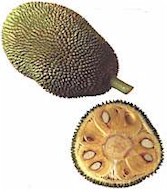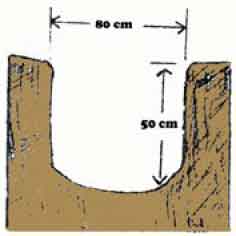Jackfruit Farming and Products
 Jackfruit scientifically known as Artocarpus heterophyllius, lam, locally known as “nangka” or “langka” is a favorite dessert of Filipinos, it is one of the most widely grown fruit crops in the Philippines. It was reported that this fruit is one of the famous in the world because it produces the largest edible fruit that weighs as much as 50kg.
Jackfruit scientifically known as Artocarpus heterophyllius, lam, locally known as “nangka” or “langka” is a favorite dessert of Filipinos, it is one of the most widely grown fruit crops in the Philippines. It was reported that this fruit is one of the famous in the world because it produces the largest edible fruit that weighs as much as 50kg. Many people believe that the leaves of the jackfruit tree can cure skin diseases. The bast of the tree is utilized in making rope and clothing. Cebuanos use the wood of the jackfruit tree in making excellent guitars and ukeleles, that’s why jackfruit orchards are becoming increasingly popular in Cebu.
More and more farmers are becoming aware of the versatility of the jackfruit and they are exploring still other possible uses for it. Aside from food, the jackfruit is also used for commercial and noncommercial purposes. The fruit, trunk, leaves, and roots can be utilized for household use or can be processed commercially.The trunk can be used as lumber or building material. The leaves can be used as medicine, fodder for animals, and compost. It latex can be used as paste or glue. The seeds can be used as food, for human consumption, feeds or planting materials while the roots can be used as handle for farm implements.
Jackfruit grows best in deep, sandy loam to clay loam soils of medium fertility with good drainage. Fertility of the soils of medium fertility with good drainage. Fertility of the soil should be considered because of the rapid exhaustion of soil nutrients taken by the plants. The ideal pH of the soil for jackfruit ranges from 5 to 6.5. Distinct variations have been observed by the National Seed Industry council in Los Baños, Laguna and the Mandaue Experiment Station in Cebu city.
VARIETIES
Several varieties of jackfruit are grown in the Philippines, however, the most important cultivars are the Sinaba and Tinumbaga.
• Sinaba variety has thick flesh, small seed, and good eating quality.
• Tinumbaga variety has thinner flesh, a stronger aroma, and sweeter taste than Sinaba.
Other varieties identified for commenrcial production in Eastern Visayas.
PROPAGATION
Jackfruit is usually propagated by seeds or by asexual propagation. Farmers who propagate by seeds should select healthy, vigorous, and disease-resistant seeds from productive mother trees.
A sexual propagation can be done by enriching or grafting. Among the grafting methods, cleft grafting appears to be the most effective as it is able to counter the devastating effects of a typhoon which usually destroys tall trees. A cleft grafted tree is high in genetic quality, grows short but strong in stature. It’s branches tend to spread sidewards.
ILLUSTRATIVE STEPS IN CLEFT GRAFTING

a) Healthy rootstock cutback to the point of grafting.
b) Healthy rootstock showing vertical incision. Shape its base into a 2-3cm.
c) Scion showing wedge cut base for easy insertion.
d) Scion inserted into the rootsock. See to it that at least one side of the graft has cambiums of both stock and scion aligned. This will ensure effective union of the graft.
e) Graft secured firmly with a budding tape. Tie the graft with a plastic tape starting from the lower portion going up. Just apply enough pressure to facilitate union without destroying the growing portion. Too much water may hamper growth and prevent union. Cover the graft with a loose wind of plastic strip and cover further with a 1” x 10” plastic wrapper.
f) Scion starting to grow.
Plant seeds in seedboxes or tin cans. Clear and clean the field at least one year before transplanting seedlings to a permanent site. A few weeks before planting,
dig holes about 60 to 80 centimeters in diameter and 40 to 50 centimeters deep. When planting, fill holes with fertile surface soil instead of subsoil dug out of the holes.

Before transplanting, prune-two-thirds of the leaves of the seedlings. Cut leafy brnaches to prevent excessive moisture loss and take special care when transplanting because the jackfruit has a delicate root system.

Also, planting distance should be no less than 10 to 12 meters between trees.
Cultivate the plants. Remove all weeds within a radius of one meter around the tree. Prune trees regularly to remove unnecessary twigs and branches.
FERTILIZATION AND IRRIGATION
Growing seedlings need ample nitrogen fertilizer while bearing trees need regular applications of phosphorous and potash.
1.) In the absence of soil analysis, apply as basal either manure or compost at the rate of 3kgs per plant or 2 metric tons per hectare. One month after planting, apply 100-150g ammonium sulfate per tree. After six months, apply an equal amount of 100-150g ammonium sulfate and towards the end of the rainy season. Organic fertilizer is advisable to apply around the trees. When trees start bearing fruits and during the start of the rainy season, apply 1/2kg-2kg complete fertilizer and 200g-300g muriate or potash (0-0-60) per tree. Every six months thereafter, apply complete fertilizer at the rate of 1 1/2kg-3kg per tree.
2.) Water requirement is less critical in jackfruit production,
however, irrigate the farm during extreme drought.
WEEDING
Periodic ring weeding and underbrush shall be done every three (3) months.
PRUNING
Prune trees at two (2) years of age. Cut the top of the main stem leaving 2-3 meters above the ground to regulate the height. Apply fungicide on resulting wounds.
Pruning consists of the removal of small unproductive branches as well as diseased and insect-damaged ones. Since fruits are usually produced on the trunk and large branches, the removal of unwanted branches would give more light to the developing fruits.
In Thailand, a uniform system of pruning is followed, that is, by pruning the main trunk well above the bud union to induce the production of multiple branches close to the ground. Allow four or main branches to grow to carry the fruits, instead of distributing the heavy fruits on the main trunk and the smaller over to the side branches. This, system also opens the center of the tree for better light penetration and air movement.
PEST AND DISEASES
1.) Fruit fly - Like most fruit rrees, jackfruit is vulnerable
to fruit fly infestation, a most destructive pest. The fruit fly lays its eggs under the skin of the fruit and which hatch in 5-6 days. The larvae work their way into the fruit, eventually causing rot and making it unfit for market. The larva comes out of the fruit and falls to the ground to pupate in the soil. An adult lays about 100 eggs in one oviposition.
To control - Wrap fruits with empty cement bags or jute sacks. Spray wrappers with pesticide to reduce fruit damage.
2.) Twig borer - Borers attack the twigs and cause the affected twigs to dry up. An adult borer is slight gray in color and about 2 cm long.
To control - Cut off all affected shoots and twigs and destroy them by burning before spraying the tree with the recommended insecticides with long residual effects. Spraying showed be done twice a month depending on the degree of infestation.
3.) Another common pest is the bark borer.
To control - This pest remove the dead branches where it lays its eggs. Spray the recommended pesticides and bum affected twigs and dead branches.
4.) Jackfruit is also attacked by the fungal pink disease,especially during the rainy season. To prevent its spread, spray plants with sulphur fungicide at least twice a month during rainy season. Always prune and burn severely affected branches.
HARVESTING
Jackfruit bears fruit at three years old. About 10 fruits can be harvested the first time the tree bears fruit.
The following are indicators of fruit ripeness:
• when the last leaf on the stalk turns yellow;
• the fruit produces dull, hollow sounds when tapped;
• its well-developed and widely spaced spines yield to moderate pressure.
The time to harvest depends on how the fruit is to be used. If it’s for home consumption, pick fruit when the rind is soft, emitting an aromatic odor, and when the leaf nearest the stalk turns yellow. At this stage, the flesh of the fruit is yellow-orange, shiny and juicy. If you plan to sell the fruit, pick it when mature but still firm and without aroma. At this stage, the flesh is pale-yellow and crisp.
Take extra care not to damage the fruit. When you cut the penduncle of the fruit with a sharp knife or sickle, be sure another person wearing hand gloves to protect his hands from spines will assist. When harvesting from tall trees, place the fruit in a sack to prevent it from falling to the ground. Tie a rope to the stalk, snap the fruit from the tree, and slowly lower the bundle to the ground.
Harvesting should be done at mid - morning to late afternoon to reduced latex flow because, at this time of the day, latex cells are less turgid. This would minimize latex stains which give the fruit an unsightly appearance. Remove the retained peduncle and unwanted water sprouts from the trunk after picking the fruit.
When handling the fruit, lay it against a railing with its stalk down to let the latex flow and coagulate. It is best to transport the fruits in single layers. Always put dried banana leaves between fruits and spread some on the container to prevent the fruits from getting bruises, scars, and breaks. Never insert a pointer stick into the fruit’s stem. Many people in the rural areas believe this technique hastens ripening but this has no basis. A cut on the stem only serves as an entry point for decay-producing organisms.
The fruit usually weighs from five to 15 kilogram; bigger ones weigh more. Fruit experts or pomologists grade the fruit according to size: large, at least 20kg; medium, at least 15kg but no more than 20kg; and small, at least 8kg but not more than 15kg. Another way of grading jackfruit is according to condition. Grade No. 1 means that the fruit is fairly well-formed, free from damage by discoloration or scars, cuts, skin breaks, diseases, and insects. Grade No. 2 means that the fruit has no specific shape, though free from cuts, skin breaks, insects, and diseases.
----------
JACKFRUIT PRODUCTS
----------
JACKFRUIT JUICE
Ingredients:
jackfruit pulp
sugar
calamsi extract
water
Procedure:
1. Steam-blanch the jackfruit pulps for five minutes.
2. Osteorize the jackfruit pulps to procedure puree.
3. Mix 1 part puree to 3 parts water.
4. Add calamansi extract and sugar to taste.
5. Cool and serve.
JACKFRUIT PRESERVE
Ingredients:
1 kg jackfruit pulp
1 kg white sugar
1 part water
Procedure:
1. Select the ripe but firm langka fruits. Remove the seeds and cut both ends of the flesh, then wash.
2. Boil syrup for 10 mins. Combine 1 part each sugar and water for every part of langka pulp. Soak overnight.
3. Drain syrup the following day. Pack in sterilized jars and pour boiling syrup. Remove bubbles, then half seal.
4. Pasteurize in boiling water for 30 mins. Seal tightly.
5. Place the jars upside down to test for leakage.
6. Cool, dry, and label.
CANDIED LANGKA
Ingredients:
1 kg langka
2 1/2 cups white sugar
1 gram sodium benzoate
Procedure:
1. Select sound, ripe langka fruit.
2. On the first day, cut langka into segments and separate edible pulp from seeds.
3. Wash it in running water and drain.
4. Dip langka in boiling water and drain.
5. Prepare syrup by boiling 2 cups water and 2 cups sugar for 5 minutes.
6. Soak langka pulp overnight in a cooled syrup.
7. On the second day drain off syrup, boil until the consistency becomes thick.
8. Repeat step no. 6
9. On the second day drain off syrup, boil until the consistency becomes thick.
10. Repeat step no. 6.
11. On the fourth day repeat step no. 9 and 10, then add 1 gram sodium benzoate. Mix well.
12. On the fifth day, drain the fruit, arrange on trays and dry in a dehydrator or under the sun for 16 hours at 52-64oC. (sun dried fruits should be pasturized in an oven for 30 minutes before wrapping).
13. Cool, wrap in cellphane and pack in polyethylene bags.
14. Label and store in a cool dry place.
JACKFRUIT JAM
Ingredients:
1 cup jackfruit puree
3/4 cup white sugar
Procedure:
1. Use fully ripe langka fruit.
2. Cut the fruit into half and separate the segments. Remove the seeds and osteorize the pulp.
3. To one cup of osteorize pulp, add 3/4 cup sugar and boil with constant stirring until thick and clear.
4. Pack while hot in sterilized jars and seal tightly.
5. Cool and serve.
References:
1. Technoguide Series, Jackfruit DA-RFU 8, eastern Visayas Integrated Agricultural Research Center (EVIARC)
2. Asexual Propagarion in Jackfruit, EVIARC leaflet No. 1
3. Jackfruit Delights, EVIARC
SOURCE: Department of Agriculture, Philippines
Tags:
Agri-Poultry Business, Food Products


Post a Comment